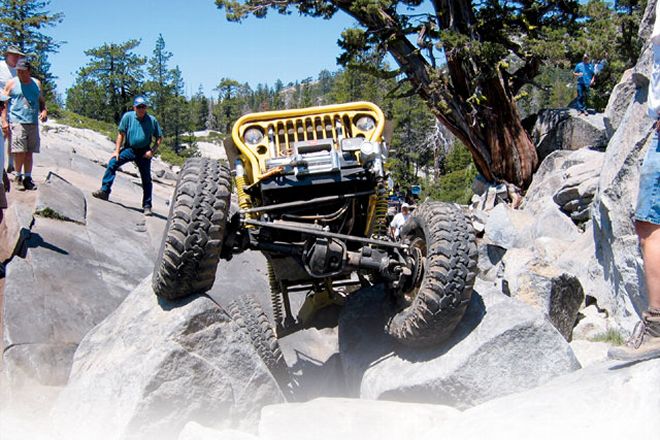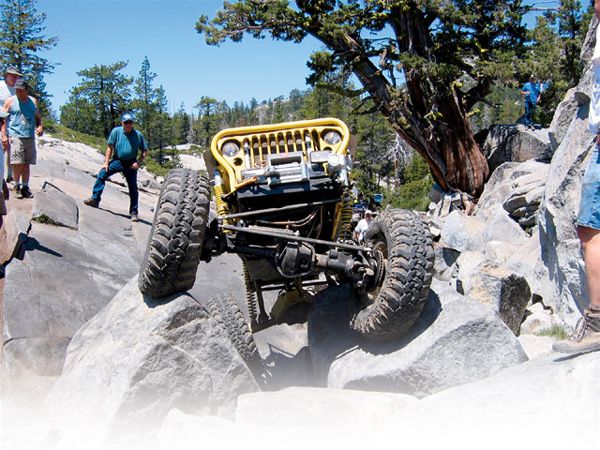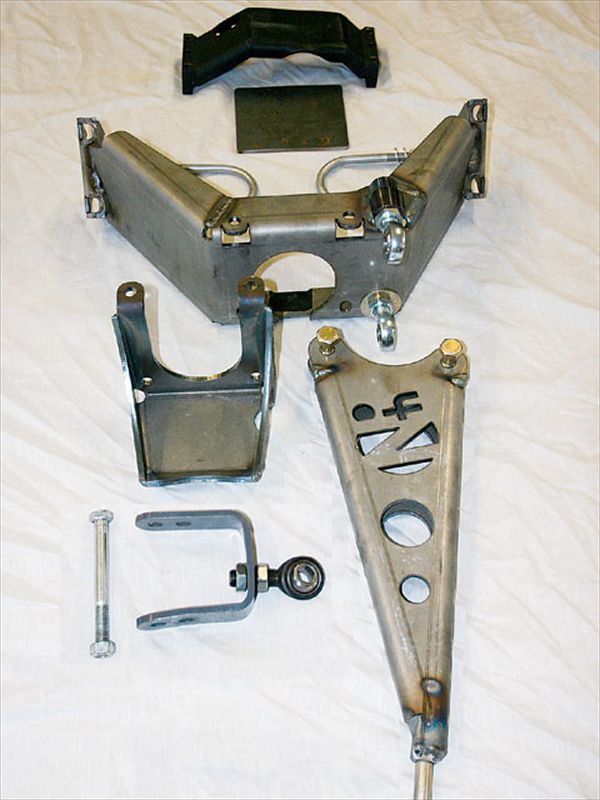
 Although our initial tests were conducted in the Hammers, we have continued flexing the Universal Stinger over every big rock we can find. Here, some hecklers look on as the Stinger helps the Bee negotiate the Little Sluice on the Rubicon Trail.
Although our initial tests were conducted in the Hammers, we have continued flexing the Universal Stinger over every big rock we can find. Here, some hecklers look on as the Stinger helps the Bee negotiate the Little Sluice on the Rubicon Trail.
In the March '06 issue, we brought you the full story on Nth Degree Mobility's long-arm suspension for Jeep TJs. This suspension is fast becoming the suspension to have under your hard-core TJ, allowing a street-driven Jeep to play with rock buggies. One of the unique components of the kit that plays a big role in its performance is the Stinger. The Stinger is a torque arm that replaces the upper control arms in a TJ's rear suspension. It distributes torque evenly to the center of the chassis and does away with several of the TJ's weird handling traits.
Now Nth Degree has designed a larger, Universal Stinger that will fit onto aftermarket high-pinion Dana 60-based rear axles. So if you've upgraded your TJ with an Nth suspension, and are now considering beefier axles, you can easily install the Stinger. Even better, if you've got a 60 of any brand under whatever your rock rig is, you can now easily install a Stinger and enjoy the traction and handling benefits it affords.
My old "Killer Bee" flatfender has been in my possession for 31 years now. The only parts left that go with the '60 Willys serial number I've held title to since 1975 are the two main framerails and the tailgate. Some say I've gone too far and it's just another rock buggy these days ... well, so be it. A vehicle that's spent a long life on big rocks just kinda ends up that way. The Bee has been, and forever will be, evolving, and its latest trick is an Nth Degree Stinger attached to its Dynatrac ProRock rear axle.
 This was the first raw prototype as delivered from Nth Degree. On the left is the production TJ-sized shackle, which proved to be too wimpy for V-8 torque and 60-sized axles. It has since been upgraded with a larger design that incorporates a gusset and a centered Heim joint. The main bracket captures and surrounds the pinion snout through the hole in the front, while the sides reach back and attach to the axletubes via U-bolts. Further attachment to the diff is provided via a weld-on plate that attaches to the Dynatrac-supplied diff bridge shown at the far right.
This was the first raw prototype as delivered from Nth Degree. On the left is the production TJ-sized shackle, which proved to be too wimpy for V-8 torque and 60-sized axles. It has since been upgraded with a larger design that incorporates a gusset and a centered Heim joint. The main bracket captures and surrounds the pinion snout through the hole in the front, while the sides reach back and attach to the axletubes via U-bolts. Further attachment to the diff is provided via a weld-on plate that attaches to the Dynatrac-supplied diff bridge shown at the far right.
I first installed coil springs and my self-designed torque arm/three-link/Panhard-bar rear suspension in 1995. At that time, I employed a centered rear torque arm that worked using the same principles as Nth's Stinger, but it was much cruder and a lot noisier. The Jeep worked great, however, and this setup was even used in the earliest rockcrawling competitions. A few years ago, I went away from this design and built a more conventional four-link wishbone-style rear-link setup. For years, I fought this design as I found the Jeep struggled more on obstacles that it used to walk over. It tended to lift front tires more as the torque load seemed to be directed at one framerail or the other.
When Jim Frens, owner and engineer of Nth Degree products, asked me if I wanted to prototype his new Universal Stinger on the Bee, I jumped at the chance. Having 'wheeled his designs on various TJs, I'm a firm believer in his chassis knowledge. If I have to employ the talent of this former Jeep engineer over my backyard "engineering" to make the old Bee sting again, I'm all over it.
The installation of the Stinger to the Dynatrac ProRock is an easy fit and can be done with the axle under the rig. The design, if a bit chunky (the production units have lightening holes), is beefy and includes a useful skidplate for the rear U-joint. I had to fabricate a forward mount for the shackle (see photos) and a Panhard (track) bar also needed to be fabricated and employed.
The first test trip was a weeklong thrash fest in the Hammers under the curious eyes of some of the most well known and oldest (read: been around the longest) rockcrawlers in the sport. I can't say the Stinger came through unscathed, as we had some strength issues with the original, TJ-based production shackle. A beefier, gusseted one has since taken its place with no more issues. Despite this minor prototype issue, the traction and handling virtues of again employing a center torque arm to the Bee brought back its days-of-old capability. The function of Nth's Universal Stinger design is well up to any flexy twisting the Hammers can offer, and all of the torque that the Bee's ZZ4, 4.3 Atlas and 40-inch Iroks could muster couldn't destroy it.





